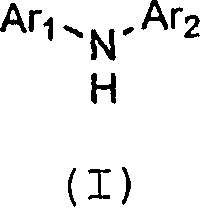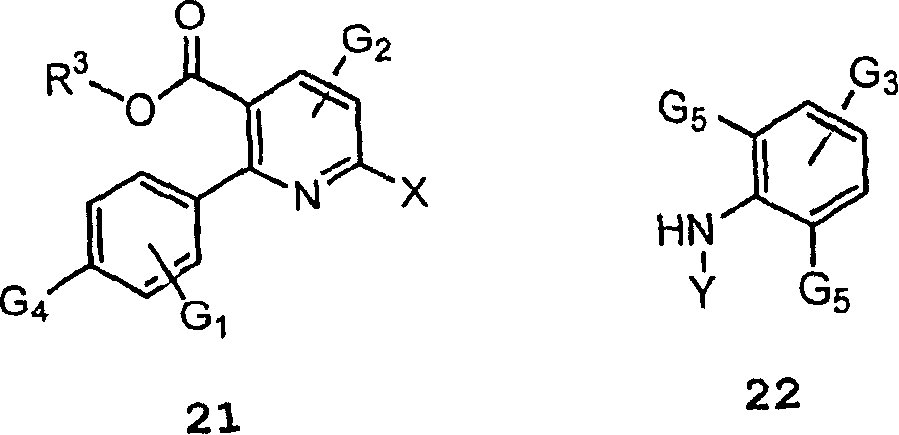Processes for the preparation of N-heteroaryl-N-aryl-amines by reacting an N-aryl carbamic acid ester with a halo-heteroaryl and analogous processes
A technology of diarylamine and aryl, applied in the field of simple synthesis of diarylamine and its analogs, can solve the problems of limited palladium catalytic range, low yield and the like, and achieve easy large-scale preparation, high yield, The effect of simple reaction conditions
- Summary
- Abstract
- Description
- Claims
- Application Information
AI Technical Summary
Problems solved by technology
Method used
Image
Examples
Embodiment 1
[0209]
[0210] 2-Chloro-nicotinic acid methyl ester (52): 52 was prepared according to the method of Synth.Comm.26(12), 2257-2272(1996). To the nitrogen purged flask was added 2-chloro-nicotinic acid (1000.0 g, 6.0 mol, 1.0 eq) followed by 9 L of dichloromethane. To this was added thionyl chloride (1.4 L, 19.7 mol, 3.2 eq) and the reaction was heated to 4OC with vigorous stirring under nitrogen overnight. The acid chloride solution was cooled in an ice bath, and methanol (3 L, 74 mol, 12 equiv) was slowly added while maintaining the temperature at 20°C. The rate-limiting parameter is the vigorous evolution of large amounts of HCl gas. After adding, HPLC analysis [T ret Raw material = 7.5 minutes, T ret 52 = 11 minutes] shows that product has been formed immediately. Volatiles were removed in vacuo with EtOAc from 10% Na 2 CO 3 Extraction residue. The combined organic layers were dried (MgSO 4 ), filtered, and concentrated to a pale yellow oil.
Embodiment 2
[0212]
[0213] 2-(4-Fluoro-phenyl)-nicotinic acid methyl ester (54): Add Pd(Ph 3 ) 4 (1.84g, 1.6mmol, 0.005eq), sodium carbonate (42.8g, 404mmol, 1.3eq), 52 (55.5g, 320.6mmol, 1.0eq), p-fluorophenylboronic acid (53.8g, 384.7mmol, 1.2eq ), followed by 1.3 L of denatured EtOH. The reactants were heated to 78°C while under N 2 Stir vigorously overnight. HPLC analysis of the reaction mixture [T ret 52 = 10 minutes, T ret 54 = 12 min] shows complete consumption of starting material, resulting in a post-eluting peak. The reaction was cooled to room temperature and the solvent was removed under vacuum. The residue was dissolved in EtOAc, washed, dried (MgSO 4 ), filtered through celite, and concentrated to give 54 as a pale yellow solid.
Embodiment 3
[0215]
[0216] 2-(4-Fluoro-phenyl)-1-oxo-nicotinic acid methyl ester (55): To a nitrogen purged flask was added urea hydroperoxide (86.9 g, 924 mmol, 4.0 equiv), diaryl Pyridine 54 (53.4 g, 231 mmol, 1.0 equiv) and 530 mL of acetic acid. Heat the pale yellow homogeneous solution to 70-75 °C while stirring vigorously under nitrogen until HPLC analysis [T ret 54 = 12 minutes, T ret 55 = 10 minutes] showed >97% complete. The reaction was cooled to room temperature and the contents were slowly poured onto 500 g of ice. To the vigorously stirred ice-like mixture was slowly added 6N NaOH to pH 7 while maintaining the temperature at 30 °C. Add EtOAc and NaHCO 3 (solid) until an aqueous pH of 8-9 is reached and the solid dissolves. The layers were separated and the aqueous layer was back extracted with EtOAc. Combine the organic layers and wash with 5% NaHCO 3 Wash, then test for the presence of oxidizing agents with peroxide paper. If the organic layer is positive for per...
PUM
 Login to View More
Login to View More Abstract
Description
Claims
Application Information
 Login to View More
Login to View More - R&D
- Intellectual Property
- Life Sciences
- Materials
- Tech Scout
- Unparalleled Data Quality
- Higher Quality Content
- 60% Fewer Hallucinations
Browse by: Latest US Patents, China's latest patents, Technical Efficacy Thesaurus, Application Domain, Technology Topic, Popular Technical Reports.
© 2025 PatSnap. All rights reserved.Legal|Privacy policy|Modern Slavery Act Transparency Statement|Sitemap|About US| Contact US: help@patsnap.com



